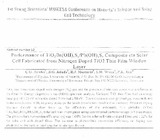| dc.description.abstract | TiO~ th in lilills were doped with nitrogen (N2) gas and the presence of nitrogen atoms was confirmed in
the films hv Energy dispersive x-ray (EDX) spectrum analysis. Undoped TiO: thin films had an energy
band gap of ~.:!5eV while the doped films had 2.90 eV. The reduction in energy band gap was auributed
10 the introduction of N, impurity stares on the bands (conduction band and or valence). Effect of doping.
titanium diox ide window layer on the efficiency of the extremely thin absorber (ET/;)
TiO?ljn(OH),S/Pb(OJ--l),Sy solar cell was investigated using conventional current-voltage (I-V) technique.
The phoiovoltaic conversion efficiency (7/) was 1.06% for the solar cell with undoped films and J32% for
the solar cell with doped films. The increase in photovoltaic conversion efficiency on doping W3S
attributed to decrease in band gap due to nitrogen doping. | en_US |

